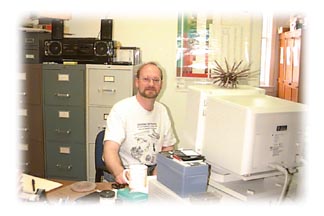| |
|
Richard J. Mooi
 B.Sc.,
M.Sc., Ph.D., University of Toronto, Canada (1981, 1983, 1987). Lecturer,
University of Toronto (1985-1986). Postdoctoral Fellow, National Museum
of Natural History, Smithsonian Institution (1988-1990). Research Associate,
Royal Ontario Museum, (1990-). Assistant Curator, California Academy of
Sciences (1990-1996). Associate Curator, California Academy of Sciences
(1996-). Fellow: California Academy of Sciences, Willi Hennig Society.
Member: Society of Systematic Biology, Paleontological Society, Society
for Sedimentary Geology, Biological Society of Washington, American Association
for the Advancement of Science. Advisory Board: Smithsonian Series in
Comparative Evolutionary Biology. Symposia (Organizer): Phylogenetics
and Heterochrony, Willi Hennig Society (1991). Symposia (Invited Speaker):
Applications of Phylogenetic Analysis, Willi Hennig Society (1991), Evolution
of Echinoderms, International Echinoderm Conference (1993), Keynote address
on Echinoderm Functional Design, 4th European Echinoderms Colloquium (1995).
Conference Organizer: 9th International Echinoderm Conference, San Francisco
(1996). B.Sc.,
M.Sc., Ph.D., University of Toronto, Canada (1981, 1983, 1987). Lecturer,
University of Toronto (1985-1986). Postdoctoral Fellow, National Museum
of Natural History, Smithsonian Institution (1988-1990). Research Associate,
Royal Ontario Museum, (1990-). Assistant Curator, California Academy of
Sciences (1990-1996). Associate Curator, California Academy of Sciences
(1996-). Fellow: California Academy of Sciences, Willi Hennig Society.
Member: Society of Systematic Biology, Paleontological Society, Society
for Sedimentary Geology, Biological Society of Washington, American Association
for the Advancement of Science. Advisory Board: Smithsonian Series in
Comparative Evolutionary Biology. Symposia (Organizer): Phylogenetics
and Heterochrony, Willi Hennig Society (1991). Symposia (Invited Speaker):
Applications of Phylogenetic Analysis, Willi Hennig Society (1991), Evolution
of Echinoderms, International Echinoderm Conference (1993), Keynote address
on Echinoderm Functional Design, 4th European Echinoderms Colloquium (1995).
Conference Organizer: 9th International Echinoderm Conference, San Francisco
(1996).
When I was about 8 years old, I sat at the kitchen table and used a
blue ballpoint pen to draw the "blueprints" for the research
vessel I would be using when I became a marine biologist. Things don't
always go the way you plan--even when you start early. But I can say that
my life as a field biologist and phylogeneticist of marine organisms has
never wavered from the exciting endeavor represented by those childhood
sketches. My parents introduced me to the wonders of the natural world,
and I discovered very soon that there was nothing I would like to do more
than devote my life to uncovering, drawing, and writing about those wonders.
But it was not until my second year at the University of Toronto that
I came up against what are arguably some of the most enigmatic of marine
organisms: the echinoderms. This group, which includes the sea urchins,
sea stars, brittlestars, sea cucumbers, and sea lilies, displays some
of the most bizarre morphologies of any marine organism. The origins of
certain peculiar evolutionary novelties are poorly known, and the echinoderms
are a perfect laboratory in which to study the far-reaching effects of
some of these, especially small changes in rates of development. In particular,
I was drawn to the aesthetically and scientifically pleasing sand dollars.
Under the tutelage of Malcolm Telford, who taught me that there were no
satisfying answers to poorly formulated questions, and Rick Winterbottom,
who taught me that the best questions were about the relationships of
organisms, I discovered my calling as a phylogenetic systematist.
Using phylogenetics as a tool, I have studied everything from abyssal
sea urchins to linguistics. My most satisfying systematic works still
deal with the sand dollars, which continue to lay the ground work for
my ideas on the relationship between development and phylogeny. Recently,
with colleagues in France, I have begun work on skeletal systems of all
echinoderm groups, both fossil and extant. This theory of skeletal homologies
provides keys to determining how these strange animals evolved. In the
same way that knowing homologies in vertebrate skeletons has helped us
to understand their evolution, our hope is that this theory of echinoderm
homologies should be helpful in explaining the origins of even the most
bizarre echinoderm groups.
Mooi, R. 1989. Living and fossil genera of the Clypeasteroida (Echinoidea:
Echinodermata): An illustrated key and annotated checklist. Smithsonian
Contributions to Zoology 488:1-51.
Mooi, R. 1990. A new "living fossil" echinoid (Echinodermata)
and the ecology and paleobiology of Caribbean cassiduloids. Bulletin
of Marine Science 46:688-700.
Mooi, R. 1990. Paedomorphosis, Aristotle's lantern, and the origin of
the sand dollars (Echinodermata: Clypeasteroida). Paleobiology
16:24 pp.
Mooi, R., and B. David. 1993. Ontogeny and origin of the brooding system
in Antarctic urechinid sea urchins (Holasteroida). Zoomorphology
113:69-78.
Mooi, R., B. David, and D. Marchand. 1994. Echinoderm skeletal homologies:
Classical morphology meets modern phylogenetics. Pages 87-95 in Echinoderms
Through Time (Echinoderms Dijon), B. David, et al. (eds), Balkema,
Rotterdam.
Mooi, R., and C.P. Chen. 1995. Weight belts, diverticula, and the phylogeny
of the sand dollars (Clypeasteroida: Echinoidea). Bulletin of Marine
Science 57:186-195.
Mooi, R. and B. David. 1998. Evolution within a bizarre phylum: homologies
of the first echinoderms. Amer. Zool. 38: 965-974.
|